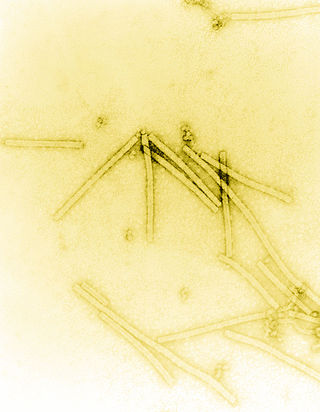
Tobacco mosaic virus (TMV) is a positive-sense single-stranded RNA virus species in the genus Tobamovirus that infects a wide range of plants, especially tobacco and other members of the family Solanaceae. The infection causes characteristic patterns, such as "mosaic"-like mottling and discoloration on the leaves. TMV was the first virus to be discovered. Although it was known from the late 19th century that a non-bacterial infectious disease was damaging tobacco crops, it was not until 1930 that the infectious agent was determined to be a virus. It is the first pathogen identified as a virus. The virus was crystallised by W.M. Stanley. It has a similar size to the largest synthetic molecule, known as PG5.

Phytolacca is a genus of perennial plants native to North America, South America and East Asia. Some members of the genus are known as pokeweeds or similar names such as pokebush, pokeberry, pokeroot or poke sallet. Other names for species of Phytolacca include inkberry and ombú. The generic name is derived from the Greek word φυτόν (phyton), meaning "plant," and the Latin word lacca, a red dye. Phytolaccatoxin and phytolaccigenin are present in many species which are poisonous to mammals if not prepared properly. The berries are eaten by birds, which are not affected by the toxin. The small seeds with very hard outer shells remain intact in the digestive system and are eliminated whole.

Wendell Meredith Stanley was an American biochemist, virologist and Nobel laureate.
A satellite is a subviral agent that depends on the coinfection of a host cell with a helper virus for its replication. Satellites can be divided into two major classes: satellite viruses and satellite nucleic acids. Satellite viruses, which are most commonly associated with plants, are also found in mammals, arthropods, and bacteria. They encode structural proteins to enclose their genetic material, which are therefore distinct from the structural proteins of their helper viruses. Satellite nucleic acids, in contrast, do not encode their own structural proteins, but instead are encapsulated by proteins encoded by their helper viruses. The genomes of satellites range upward from 359 nucleotides in length for satellite tobacco ringspot virus RNA (STobRV).

Plant viruses are viruses that affect plants. Like all other viruses, plant viruses are obligate intracellular parasites that do not have the molecular machinery to replicate without a host. Plant viruses can be pathogenic to higher plants.

Brome mosaic virus (BMV) is a small, positive-stranded, icosahedral RNA plant virus belonging to the genus Bromovirus, family Bromoviridae, in the Alphavirus-like superfamily.

Phytolacca americana, also known as American pokeweed, pokeweed, poke sallet, dragonberries, and inkberry, is a poisonous, herbaceous perennial plant in the pokeweed family Phytolaccaceae. This pokeweed grows 1 to 3 metres. It has simple leaves on green to red or purplish stems and a large white taproot. The flowers are green to white, followed by berries which ripen through red to purple to almost black which are a food source for songbirds such as gray catbird, northern mockingbird, northern cardinal, and brown thrasher, as well as other birds and some small non-avian animals.

Potyvirus is a genus of positive-strand RNA viruses in the family Potyviridae. Plants serve as natural hosts. The genus is named after member virus potato virus Y. Potyviruses account for about thirty percent of the currently known plant viruses. Like begomoviruses, members of this genus may cause significant losses in agricultural, pastoral, horticultural, and ornamental crops. More than 200 species of aphids spread potyviruses, and most are from the subfamily Aphidinae. The genus contains 190 species.

Begomovirus is a genus of viruses, in the family Geminiviridae. They are plant viruses that as a group have a very wide host range, infecting dicotyledonous plants. Worldwide they are responsible for a considerable amount of economic damage to many important crops such as tomatoes, beans, squash, cassava and cotton. There are 445 species in this genus.

A mosaic virus is any virus that causes infected plant foliage to have a mottled appearance. Such viruses come from a variety of unrelated lineages and consequently there is no taxon that unites all mosaic viruses. All the symptoms of each virus or complex appear the same, so the only way to know exactly which viral subtype is infecting a plant is to send it to a local extension service. Alternatively, commercial testing kits exist for settings like greenhouses.
Xiphinema diversicaudatum is an amphimictic ectoparasitic nematode species. This species has a characteristically long stylet capable of penetrating into a host's vascular tissue. They have a wide host range with some of the extensively studied ones being strawberry, hops and raspberry, due to their economic importance. The direct root damage caused through penetration near the root tip and formation of galls is a secondary concern when compared with the damage caused by vectoring the Arabis mosaic virus. The virus attaches to the interior cuticle lining and can be transferred from infected to uninfected root tissue as the nematode feeds and sheds. Management of this particular nematode relies on nematicides such as 1,3-Dichloropropene (Telone) at 40 gpa.or methyl bromide at 1000 lb/ac to control to 28 in deep.
Arabis mosaic virus is a viral plant pathogen that is known to infect multiple hosts. The pathogen, commonly referred to as ArMV, is from the family Secoviridae, and it causes yellow dwarf of raspberry and is one of the causes of mosaic of rhubarb. Arabis mosaic virus infects multiple hosts, including strawberries, hops, hemp, grape, geraniums, raspberries, sugar beets, celery, horseradish, lilac, peach, and lettuces.

Cucumber mosaic virus (CMV) is a plant pathogenic virus in the family Bromoviridae. This virus has a worldwide distribution and a very wide host range, having the reputation of the widest host range of any known plant virus. It can be transmitted from plant to plant both mechanically by sap and by aphids in a stylet-borne fashion. It can also be transmitted in seeds and by the parasitic weeds, Cuscuta sp. (dodder).

Sugarcane mosaic virus (SCMV) is a plant pathogenic virus of the family Potyviridae. The virus was first noticed in Puerto Rico in 1916 and spread rapidly throughout the southern United States in the early 1920s. SCMV is of great concern because of the high economic impact it has on sugarcane and maize.

Potexvirus is a genus of pathogenic viruses in the order Tymovirales, in the family Alphaflexiviridae. Plants serve as natural hosts. There are 48 species in this genus, three of which are assigned to a subgenus. Diseases associated with this genus include: mosaic and ringspot symptoms. The genus name comes from POTato virus X).

Betaflexiviridae is a family of viruses in the order Tymovirales. Plants and fungi serve as natural hosts. There are 108 species in this family, assigned to 13 genera in two subfamilies. Diseases associated with this family include mosaic and ringspot symptoms.

Antiviral proteins are proteins that are induced by human or animal cells to interfere with viral replication. These proteins are isolated to inhibit the virus from replicating in a host's cells and stop it from spreading to other cells. The Pokeweed antiviral protein and the Zinc-Finger antiviral protein are two major antiviral proteins that have undergone several tests for viruses, including HIV and influenza.

Emaravirus is a genus of negative-strand RNA viruses which infect plants. The plant virus group is the sole genus in the family Fimoviridae. The genus has 21 species.

Caulimovirus is a genus of viruses, in the family Caulimoviridae order Ortervirales. Plants serve as natural hosts. There are 12 species in this genus. Diseases associated with this genus include: vein-clearing or banding mosaic.















